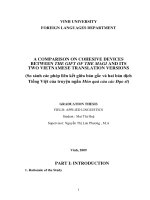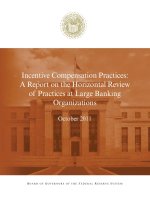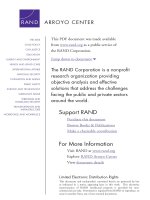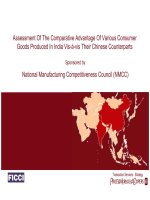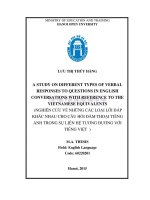A REPORT ON COMPARATIVE ADVANTAGE OF THE VIETNAMESE ECONOMIC GROWTH IN STEEL INDUSTRY UNDER THE EFFECTS OF COVID 19
Bạn đang xem bản rút gọn của tài liệu. Xem và tải ngay bản đầy đủ của tài liệu tại đây (1.09 MB, 25 trang )
INS2005 INTERNATIONAL ECONOMICS
A REPORT ON
COMPARATIVE ADVANTAGE OF THE
VIETNAMESE ECONOMIC GROWTH IN STEEL
INDUSTRY UNDER THE EFFECTS OF COVID-19
Prepared by Group 09:
1/ Nguyễn Thu Hương
ID: 18071117
2/ Nguyễn Thị Thanh Hằng
ID: 19071357
3/ Đỗ Thị Hồng
ID: 17071075
4/ Lô Thị Trà My
ID: 19071428
5/ Bùi Phương Thảo
ID: 18071409
6/ Nguyễn Thị Minh Thư
ID: 19071514
Hanoi, October 2021
download by :
GROUP 09
INS2005 – INTERNATIONAL ECONOMICS
TABLE OF CONTENT
INTRODUCTION............................................................................................... 3
•
About our group .............................................................................................................. 3
•
About this report ............................................................................................................. 4
CHAPTER 1: OVERVIEW THE VIETNAMESE ECONOMY AND
STEEL INDUSTRY ............................................................................................ 5
1.1. Vietnamese Economy ...................................................................................................... 5
1.2. Vietnamese Steel Industry ............................................................................................... 5
CHAPTER 2: THE VIETNAMESE STEEL INDUSTRY’S GROWTH ...... 6
2.1. Value Chain Analysis ...................................................................................................... 6
2.2. Economic Factors............................................................................................................ 9
2.3. Production Situation...................................................................................................... 11
2.3. Main Businesses............................................................................................................ 13
CHAPTER 3: COMPETITIVE ADVANTAGES OF STEEL INDUSTRY. 14
3.1. Factor of Production ..................................................................................................... 14
3.1.1. Steel Production ..................................................................................................... 14
3.1.2. Labor Resources..................................................................................................... 15
3.2. Demand Conditions ...................................................................................................... 15
3.2.1. Global Demand ...................................................................................................... 15
3.2.2. Domestic Consumption .......................................................................................... 16
3.3. Supporting Industries .................................................................................................... 17
3.4. Strategies and Competition ........................................................................................... 17
3.4.1. Strategies ................................................................................................................ 17
3.4.2. Competition............................................................................................................ 18
CHAPTER 4: CONCLUSION......................................................................... 19
4.1. Summary ....................................................................................................................... 19
4.2. Assessment .................................................................................................................... 20
4.2.1. Advantages ............................................................................................................. 20
4.2.2. Disadvantages ........................................................................................................ 20
4.2.3. Recommendations .................................................................................................. 21
REFERENCES .................................................................................................. 23
Page 2 of 25
download by :
INS2005 – INTERNATIONAL ECONOMICS
GROUP 09
INTRODUCTION
• About our group
We are Group 9 with 6 members.
Table 1
Members’ Contribution
GROUP 09
No.
Name
Student
Contribution
ID
Rate
Being Responsible For
- Conduct report
Nguyễn Thu Hương
1
18071117 100%
- Summary (4.1)
(Leader)
- Contribute to other parts as adjuster
2
Nguyễn Thị Thanh Hằng
19071357 100%
- Chapter 3
3
Đỗ Thị Hồng
17071075 100%
- Value Chain Analysis (2.1)
- Economic Factors (2.2)
4
Lô Thị Trà My
19071428 100%
- Production Situation (2.3)
- Main Businesses (2.4)
- Chapter 1
5
Bùi Phương Thảo
18071409 100%
- Assessment (4.2)
6
Nguyễn Thị Minh Thư
19071514 100%
- Chapter 3
Note. All work-breakdowns are transparently assigned among every member.
Page 3 of 25
download by :
INS2005 – INTERNATIONAL ECONOMICS
GROUP 09
• About this report
Nowadays, international trade is a tendency of commerce all over the world, so
analytical skill is becoming increasingly important in the field of trade. In general, knowing
the situation of home country’s economic is the basic fundamental to develop any businesses
and operations. Face with the situation of Covid-19 pandemic, Vietnamese economy still has
the advantages not to deeply influence. Then, steel industry is an emerging industry that provide
a potential chance for Vietnamese economic growth along with the development of steel
corporation.
Given the importance of analytical skill, this paper will research in the Vietnamese
economic growth in steel industry based on the real situation and its competitive advantages.
In addition, this paper will give some assessment as long as recommendations to benefit from
this industry.
By reading this report, you will have knowledge about the growth of Vietnamese economy in
steel industry then aware about its competitive advantages in the context of Covid-19
pandemic.
HOPE YOU LIKE IT!
Page 4 of 25
download by :
INS2005 – INTERNATIONAL ECONOMICS
GROUP 09
CHAPTER 1: OVERVIEW THE VIETNAMESE ECONOMY AND STEEL
INDUSTRY
1.1. Vietnamese Economy
In recent years, Vietnam's economy has been spectacular. The economic and political
reforms under renovation period have resulted in fast corporate finance growth, changing
Vietnam to a middle-income country.
Despite of the fact that the economy was severely impacted by the Covid-19 epidemic
in 2020, the Vietnamese economy increased by approximately 3%, making it one of the few
countries in the region and the world to have positive growth. The macro-economy is largely
stable, and markets run smoothly, allowing people and businesses to concentrate on production
and business.
During the time 2016-2020, the inflation rate was steadily reduced from three digits in
the early years of the renovation era to the goal level of 4%. With a slew of large-scale and
high-tech projects, foreign direct investment capital soared, opening up a slew of prospects for
domestic economic cooperation in production, business, and technology transfer.
Recently, Vietnam has signed two high-potential accords, EVFTA and RCEP, and has
gone from being a deficit country to balancing imports and exports, even having a trade surplus.
Vietnam's economy grew solidly at 5.6 percent in the first half of 2021, according to a new
World Bank assessment, but it faced major threats both within and outside.
1.2. Vietnamese Steel Industry
The Covid-19 pandemic has hit many parts of the globe for a long time, the domestic
steel industry continues to face challenges due to the stagnation of manufacturing industries
Page 5 of 25
download by :
INS2005 – INTERNATIONAL ECONOMICS
GROUP 09
using steel for construction industry, infrastructure, automobiles, motorbikes... and competitive
pressure from increasing domestic supply.
However, in 2020, despite facing many difficulties due to complicated developments
of the Covid-19 epidemic, the steel industry still recorded good growth. In addition, in the face
of opportunities from integration, especially the implementation of trade agreements, the
removal of a series of tariffs will help Vietnamese steel enterprises expand the export market.
Besides, the import of raw materials from countries in the bloc that have signed FTAs
will also help Vietnam benefit in price. Facing opportunities from international economic
integration, especially the implementation of new agreements, the steel industry is expected to
have more conditions to attract investment, promote production and export to new markets.
However, at present, the steel industry still has to compete fiercely with imported steel
penetrating strongly into the Vietnamese market.
CHAPTER 2: THE VIETNAMESE STEEL INDUSTRY’S GROWTH
2.1. Value Chain Analysis
The typical value chain in steel industry includes the production of hot rolled coil
(HRC) from iron ore, as known from the raw materials. Iron ore, coal and lime are smelted into
pig iron. From smelted cast iron to Steel slab, from rolled billet to hot rolled coil, then continue
the cold rolling process to achieve the required thickness and hardness, the product is cold
rolled steel (CRC). From cold rolled steel, people use it to galvanize, cold galvanize (GI/GL)
to use or continue to color it into color coated corrugated iron (PPGI).
Figure 2.1.1
Steel production process
Page 6 of 25
download by :
INS2005 – INTERNATIONAL ECONOMICS
GROUP 09
Note. Adapted from: />Currently, Vietnam's steel industry is lacking in two production stages in the steel
industry value chain, which is the production of slabs (slab) and hot rolled coil (HRC) leads
Vietnam have to import 100%.
Domestic companies have not yet made any noticeable move to invest in HRC
production plants, the reason why investing in this industry requires large capital investment
and high-tech workforce. Investment capital in a hot rolled steel factory with a capacity of 1.2
million tons per year, produced from slab billets will cost about $ 400 million.
In this value chain, Vietnam only owns 40%, may not meet the regulations on the
proportion of domestically produced goods according to the rules of origin in the TPP: this
ratio can fluctuate from 35-55 % depends on the specific industry. Therefore, after applying
TPP, Japan has the advantage of supplying HRC to Vietnam. Because if using Japan's HRC,
Vietnam's coated steel products will reach the origin of nearly 100% of domestic production in
the TPP.
Figure 2.1.2
Vietnam value chain in steel industry
Page 7 of 25
download by :
GROUP 09
INS2005 – INTERNATIONAL ECONOMICS
Note. Adapted from: />In the next few years, Formosa HT has the advantage of supplying HRC steel. The year
2020 is a lucky year for Vietnam's steel sector, particularly the galvanized steel industry. No
one could have predicted such a significant comeback in galvanized steel demand, especially
in the third quarter of 2020, from both the local and foreign markets. For three years in a row,
the output of galvanized steel sheet manufacture has remained steady. 4.4 million tons in 2018,
4.2 million tons in 2019, and 4.4 million tons in 2020.
In addition, Vietnam's galvanized steel products have a prominent international
presence, with annual exports of 1.4-1.75 million tons earning over one billion dollars and
helping to the reduction of the iron trade deficit. Every year, around 5 billion dollars are spent
on steel.
Page 8 of 25
download by :
INS2005 – INTERNATIONAL ECONOMICS
GROUP 09
2.2. Economic Factors
Vietnam's economy has been overgrowing for several years. The increasing
development of steel demand has enticed numerous steel companies to invest in new
production facilities in Vietnam.
Figure 2.2.1:
Vietnam GDP growth rate in 2016-2020
Note. Adapted from: />In 2020, Vietnam's GDP growth rate will be 2.91 percent, relatively high in Southeast
Asia. The relationship between the increase in steel consumption and GDP growth is apparent,
which entails requirements for developing and constructing infrastructure, roads, traffic,
housing, and real estate to meet development needs. Therefore, the growth in high construction
leads to an increase in steel demand.
Moreover, Vietnam has low-interest rates in 2020 reported at 6,2729. Vietnam's steel
consumption per capita is at 149.7kg/person in 2010. By 2019, the average steel consumption
per capita has increased to 241kg, ranking 4th among the countries. ASEAN countries.
Page 9 of 25
download by :
INS2005 – INTERNATIONAL ECONOMICS
GROUP 09
Figure 2.2.2:
Vietnam's per capita crude steel consumption ranks in four in ASIAN (2018)
Adapted
Note.
from:
/>
news/metals/101119-analysis-aseans-2019-2020-scrap-needs-to-grow-amid-steel-glutconcerns.
Balanced development Vietnam's steel industry in recent years has developed relatively
quickly. Vietnam has high potential for export growth. Despite the COVID-19 pandemic,
Vietnam exported 9.86 million tons of steel worth $5.26 billion in 2020, up 47.9% over the
same period last year.
In the 2016-2020 period, Vietnam's economy has always maintained macroeconomic
stability, average inflation increased by 3.15%/year, lower than the 4% target set by the
National Assembly. Inflation pressure will cool down from August to December 2021 thanks
to a decrease in the CPI of the food group and keeping the forecast of the average CPI in 2021
increasing by 2.9% over the same period. In particular, construction steel price carried an
uptrend in the context of the price of input materials such as iron ore, steel billet, scrap, and
transportation costs continued to increase.
Page 10 of 25
download by :
INS2005 – INTERNATIONAL ECONOMICS
GROUP 09
2.3. Production Situation
Although the unexpected pandemic made the situation difficult for the steel industry,
the case has been improving as the government's control of the health crisis and the prime
minister's drastic directions sped up public investment. Steel production of all kinds hit 2.45
million tons in November, rising 4.34 percent month over month and 15.6 percent year over
year. In addition, sales were 2.45 million tons, a significant rise of 36.9% over October. In
2020, Vietnam's steel industry has risen to 14th place in the world. This is a very good step
forward on the world steel industry map, Vietnam's crude steel production has reached a very
high level of 19.5 million tons/year.
Figure 2.3.1
Steel production in 2020
Note. Adapted from: />In terms of crude steel, steel companies in Vietnam produced 3,192,000 tons during
this time, up 28% from the same period in 2020. Consumption increased by 35% year on year
to 3,126,000 tons. When it comes to construction steel, both manufacturing output and
consumption have declined since January 2021 and the same period in 2020 but this increased
somewhat in the first two months of 2021 compared to the same period last year.
Page 11 of 25
download by :
INS2005 – INTERNATIONAL ECONOMICS
GROUP 09
The Covid-19 pandemic has had a minor influence on Vietnam's steel output. Still, it
has had a considerable impact on other nations, providing the opportunity for Vietnamese
manufacturers to extend their market share, especially in the EU, China and Thailand.
Figure 2.3.2
Vietnam’s steel export volume, by country (tons)
Note. Adapted from: g/vietnam-steel-export-in-2021-set-togrow-further-316030.html?_x_tr_sch=http&_x_tr_sl=en&_x_tr_tl=vi&_x_tr_hl=vi&_x_tr
Then, in the export field, according to the General Department of Vietnam Customs,
Vietnam exported 9.86 million tons of steel and received $5.26 billion in 2020, representing a
growth of 47.9% and 25% year over year. Furthermore, according to World Steel, 1.65 billion
tons of crude steel will be produced this year, with production rising by 3.8% to 1.71 billion
tons in 2021.
Figure 2.3.3
Steel export growth, by segment
Page 12 of 25
download by :
INS2005 – INTERNATIONAL ECONOMICS
GROUP 09
Note.
Adapted
from:
/>
further-316030.html.
On the other hand, the total amount of iron and steel imported into Vietnam in 2020
was approximately 13.26 million tons, worth nearly $ 8.1 billion; the average price per ton was
608.4 USD. Its volume, turnover, and price have all decreased by 8.9%, 15.2%, and 6.9%,
respectively, when compared to 2019.
2.3. Main Businesses
In the first half of 2020, due to the impact of the Covid-19 pandemic. Having many
members of the Vietnam Steel Association (VSA) experienced a decrease in revenue.
However, the market started to have positive changes in the second half of 2020 that prominent
businesses gain profit back.
First of all to mention is Formosa Ha Tinh Steel Corporation. The company's total sales
in the first quarter of 2021 were 1,094 million dollars, up 56 percent over the same period in
2020. Sheet billet, large plate billet, and small plate billet output totaled 1,627 thousand tons,
an increase of 17% over the same year.
Page 13 of 25
download by :
INS2005 – INTERNATIONAL ECONOMICS
GROUP 09
Secondly, Hoa Phat Group is one of Vietnam's leading industrial manufacturing
conglomerates. Hoa Phat Group is Vietnam's most significant construction steel and steel pipe
maker, with market shares of 32.5 percent and 31.7 percent, respectively, with a capacity of
over 8 million tons of steel of all kinds.
Last but not least, Hoa Sen Group Joint Stock Company was the first private company
in Vietnam to develop a cold-rolled steel plant. Hoa Sen Group expects to sell 1.8 million tons
of steel of all kinds in 2021, up 11% from the previous year.
CHAPTER 3: COMPETITIVE ADVANTAGES OF STEEL INDUSTRY
3.1. Factor of Production
3.1.1. Steel Production
The general technology level of Vietnam's steel industry is not high but most steel
factories in our coutry perform the final stage of rolling steel as pushing the advantage. Some
enterprises with geographical advantages such as Thai Nguyen exploit ore and produce steel
by blast furnace technology. Some enterprises established in recent years scrap steel and use
electric arc furnace to produce billet and steel. Although the highest furnace in Vietnam is only
500 m3 like Thai Nguyen steel, this still produce the suitable amount of production to meet the
demands.
In Vietnam, most of the scrap steel is used to produce billets and completely square
billets to make construction steel. Domestic production of square billet can meet about 50% of
steel rolling demand, the remaining 50% is from imported sources. So, domestic steel prices
do not fluctuate too much with the world billet prices.
Page 14 of 25
download by :
INS2005 – INTERNATIONAL ECONOMICS
GROUP 09
3.1.2. Labor Resources
Steel industry is increasingly scale up and tend to attract more labor force that the labors
can promote their careers and get higher standard of living. The human resource of the Steel
industry currently accounts for 2.8% of the total labor force of the industry.
High skilled workers of Vietnam in steel industry can be seen as relatively high
proportions. A survey at the Vietnam Steel Corporation shows that 3,100 workers with a
university degree or higher (2,300 men, 800 women), accounting for over 18% of the total
workforce and highly skilled workers is 3,300 people, accounting for nearly 20% of the total
number of employees of the Corporation. Among workers with professional qualifications from
university or higher, the proportion of workers with university degrees is 98.77% - accounting
for the vast majority. The quality of human resources in the steel industry for many years always
focused right from the selection of input human resources for production.
3.2. Demand Conditions
3.2.1. Global Demand
Strong steel demand from the EU and North America will be the main driver of export
volume growth in 2021. The main reason comes from the fact that the steel mills of the main
exporting countries to these markets have not returned to full operation, giving Vietnam the
opportunity to participate in the market.
The EU-Vietnam Free Trade Agreement (EVFTA) has helped Vietnamese steel
products to be present in EU market. In particular, the EU imposed steel import quotas on
Turkey and China, creating a great demand for Vietnam coated steel sheet since Q2.2020.
Besides, the domestic steel price is maintained at a lower level than the world, which is a big
advantage, leading to increased demand.
Page 15 of 25
download by :
INS2005 – INTERNATIONAL ECONOMICS
GROUP 09
Table 3.2.1.1
High demand for steel worldwide (unit: million tons).
Nation
China
India
USA Japan
South
Russia
Germany Turkey VN
Mexico
Korean
2020
995
88.5
80
52.6
49
42.5
31.1
29.5
23.3
21.7
2021 Forecast
1024.9 106.1
86.5
56
51.5
43.8
34
35
24.5
23.4
2022 Forecast
1035.1
90.2
558.8
52.8
45.1
35.8
37
26.3
24.6
112
Note. Created by the authors through data collected from World Steel.
3.2.2. Domestic Consumption
Now the epidemic has been gradually controlled, promising that domestic steel
consumption will increase positively again. The table below will show the amount of domestic
steel consumption through years.
Table 3.2.2.1
Domestic steel consumption (unit: million tons).
Domestic steel consumption
2017
2018
2019
2020
6T2020
6T2021
6T YoY
Million tons
14.32
17.07
18.57
18.71
8.55
10.68
25%
Note. Created by the authors through data collected from Fiinpro, synthesized DSC.
Page 16 of 25
download by :
INS2005 – INTERNATIONAL ECONOMICS
GROUP 09
Although the disbursement progress for public investment is still slow, many
construction projects are still stagnant, but the domestic consumption of steel in the first 6
months of 2021 period increased by 25% to 10.68 million tons, which is a very optimistic signal
for the steel market.
3.3. Supporting Industries
Steel industry is the backbone industry of Vietnam in the process of building and
developing the country, especially in the current period. The steel industry not only contributes
a large amount of income to the economy with an estimated profit of 1659 billion VND, but
also an extremely important input for other industries, especially the construction industry.
Especially with the rapid growth of the steel industry (up to 25 to 30% a year on average
from 1995 to present), the steel industry has contributed greatly to the economic restructuring
process towards increasing the proportion of industry and services and reducing the proportion
of the agricultural sector.
3.4. Strategies and Competition
3.4.1. Strategies
In the context of the global Covid-19 pandemic, the development efforts of Vietnam's
steel industry have made a particularly important contribution to the country's industrialoriented development and modernization. Besides, the industry also makes an important
contribution to the process of transformation and urbanization of the country, affecting many
aspects to the socio-economic development.
The Vietnamese steel industry can develop strategy: building a Vietnamese steel brand
commensurate with its scale, encouraging new investors to invest in the iron and steel
production complex in coastal areas, having a deep-water port, inheriting achievements in the
steel production industry, promoting development in the direction of "taking a shortcut",
Page 17 of 25
download by :
INS2005 – INTERNATIONAL ECONOMICS
GROUP 09
applying new technologies, meeting the needs in construction, and meeting important input
materials for the mechanical engineering industry, etc.
3.4.2. Competition
3.4.2.1. Competition among Domestic Enterprises
Competition among domestic enterprises has begun to increase since the end of 2019.
Vietnam with good disease control, is the only unit with positive growth in the region, with the
advantage of geographical location, low labor costs are attracting strong FDI inflows. The
demand for investment in factories and industrial parks is increasing sharply, leading to an
increase in the demand for construction steel that leads the industry to promote.
3.4.2.2. Competitive Advantages over China
Until now, Vietnam's steel industry has always faced fierce competition from Chinese
steel because this market has the advantage of large-scale production. However, with the
current rising coal price, Vietnamese steel has great competitiveness in the market due to
cheaper production costs than China.
Since China imposed unofficial sanctions on Australian coal in mid-2020, China has
faced supply shortages, increasing steel production costs. Currently, in the context of a sharp
increase in coal prices and high-power generation costs, the price of BOF Vietnam steel mainly
using coke imported from Australia seems to have a slight cost advantage compared to steel
using technology EAF furnaces.
Moreover, China is facing the problem of reducing the proportion of BOF technology
in steel production while ensuring enough output for consumption demand. Therefore,
Vietnamese steel has a great advantage.
Page 18 of 25
download by :
INS2005 – INTERNATIONAL ECONOMICS
GROUP 09
CHAPTER 4: CONCLUSION
4.1. Summary
In recent years, Vietnam's economy has flourished. Despite facing numerous challenges
as a result of the Covid-19 epidemic's convoluted evolution, the steel sector grew at a healthy
rate in 2020. However, the steel industry currently faces stiff competition from imported steel,
which has a solid foothold in the Vietnamese market.
Vietnam has significant export development potential. Steel production has risen
steadily over time. Each type of steel has a different consumption pattern, but total consumption
has increased in 2021. The Covid-19 epidemic has had a small impact on steel production in
Vietnam. Nonetheless, it has had a significant impact on other countries, allowing Vietnamese
firms to expand their market share, particularly in the EU, China, and Thailand.
Although Vietnam's steel industry does not have a high degree of technology, most steel
companies in our country perform the last stage of rolling steel as a pushing advantage. The
steel business is growing and attracting more workers so that they can advance in their careers
and have a better quality of living.
Steel export volume growth will mostly be driven by strong steel demand from the EU
and North America. Steel consumption in the United States grew, signaling a bright future for
the steel industry. Furthermore, as Chinese steelmakers' competitiveness deteriorates,
Vietnamese companies may find new chances in overseas markets, as well as larger earnings
in their own market.
The steel industry's development efforts have made a significant contribution to
Vietnam's industrial-oriented development and modernization, which necessitates the
development of strategies for the Vietnamese steel industry to obtain competitive advantages,
not only among domestic enterprises but also in international competition.
Page 19 of 25
download by :
INS2005 – INTERNATIONAL ECONOMICS
GROUP 09
4.2. Assessment
4.2.1. Advantages
With a definite recovery in the steel industry in the latter months of 2020, it is expected
that the steel industry will have a favorable outlook in 2021, with steel demand expected to rise
due to macroeconomic recovery, a strong investment wave, and a heavy focus on infrastructure.
In addition, in light of opportunities from international economic integration,
particularly the execution of trade agreements, the elimination of a number of barriers will
assist Vietnamese steel companies in expanding their export markets. Besides, the import of
raw materials from countries in the bloc that have signed FTAs will also help Vietnam benefit
from price.
The steel industry not only contributes a large amount of income to the economy, but
also an extremely important input for other industries. The development efforts of Vietnam's
steel industry have made a particularly important contribution to the country's industrialoriented development and modernization that requires to develop strategies for the Vietnamese
steel industry to gain competitive advantages. Vietnamese steel industry has competitive
advantages in production, labor force, both domestic consumption and global demands as well
as the price advantage over China – a big direct competitor.
4.2.2. Disadvantages
At present, the steel industry is also facing many difficulties due to the Covid-19
epidemic, similar to the general situation of the global steel industry.
Page 20 of 25
download by :
INS2005 – INTERNATIONAL ECONOMICS
GROUP 09
Many countries have applied social distancing measures to limit the spread of the
Covid-19 epidemic, disrupting supply, while production activities are stalled, leading to
demand for products from iron and steel slowed down, prices fell.
The steel production lines still have to maintain continuously and stably, but due to the
complicated developments of the COVID-19 epidemic, the supply and demand imbalance in
the market has been disrupted.
Since the outbreak at the end of April 2021 until now, the COVID-19 epidemic situation
has been complicated, many localities across the country have implemented social distancing.
Therefore, basic construction from industrial to civil has stopped, domestic steel consumption
has decreased sharply. In this scenario, the adjustment and lowering of import taxes on
domestic steel products will result in a flood of foreign steel, jeopardizing the production
operations of domestic firms already struggling.
4.2.3. Recommendations
In order to seize the opportunities, steel companies must continue to actively monitor
the market and demonstrate their competitiveness through product reorganization to secure
long-term growth. They must be aware of the importance of improving productivity,
technology, improving qualifications and skills of employees, working environment...
Furthermore, the state must have a comprehensive plan and strategy for developing the steel
sector, which includes limiting the creation of new construction steel plants and encouraging
businesses to invest in technologies to bring to market. high-quality special steel goods market.
In addition, it is necessary to thoroughly solve the domestic supply-demand imbalance,
create a competitive position in the international market, and avoid getting entangled in
unnecessary trade remedy lawsuits. From there, it will contribute to quickly helping to build a
Page 21 of 25
download by :
GROUP 09
INS2005 – INTERNATIONAL ECONOMICS
synchronous and modern steel industry, creating an equal business environment for enterprises
to expand their domestic and export market share.
TOTAL WORDS COUNT: 3347
(From the beginning of Chapter 1 to the end of Chapter 4)
Page 22 of 25
download by :
INS2005 – INTERNATIONAL ECONOMICS
GROUP 09
REFERENCES
1. Co Khi Ngai Cau, (2020). Góc nhìn tổng quan ngành thép năm 2020. [online] Available at:
[Accessed 20 Oct. 2021].
2. Đào, D. (2021). Dịch Covid-19: Ngành thép tăng trưởng nhờ xuất khẩu. [online] Vietnam
News Agency. Available at: [Accessed 20 Oct. 2021].
3.
Đặng,
H.
Báo
cáo
ngành
thép.
Habubank
Securities.
/>portID%3D797&sa=D&source=docs&ust=1635343606450000&usg=AOvVaw37deniUl0wF
v2L90IO6jmE
4. Nguyễn, L. (2018). Báo cáo ngành thép tháng 8/2018. [online] Academia. Available at:
/>A9p_Steel_Industry_Report_-_Vietnamese_Version
[Accessed 20 Oct.2021].
5. HT. (2020). Chinh sach giam thue thu nhap chinh thuc co hieu luc. [online]
Doanhnhansaigon.vn. Available at: [Accessed 16
Oct.2021].
6. Crowe, (2020). Detailed guidance on the 30% reduction in CIT payable in fiscal year 2020.
[online] Available at: [Accessed 16 Oct.2021].
7. Thái, D. and Xuân, T. (2021). Chính sách thuế hỗ trợ Doanh nghiệp vừa và nhỏ trong đại
dịch của Việt Nam so với một số nước. [online] Phaply.vn. Available at:
Page 23 of 25
download by :
INS2005 – INTERNATIONAL ECONOMICS
GROUP 09
[Accessed 16 Oct.2021].
8. Luong, H. and Vu, P. (2019). Báo cáo cập nhật Ngành Thép. [pdf] Vietinbank Securities.
Available at: [Accessed 16 Oct.2021].
9. Mạnh, Đ. (2021). Duy trì mức thuế chống bán phá giá 10,64% đối với thép chữ H của
Malaysia. [online] VnEconomy Available at: [Accessed 17 Oct.2021].
10. VietnamCredit, (2021). Steel companies in vietnam to export over 1 million tons of steel in
the first two months this year. [online] Available at: [Accessed 23 Oct.2021].
11. VietnamCredit, (2021). Top 10 largest steel companies in vietnam in 2021. [online]
Available at: [Accessed 23 Oct.2021].
12. DSC Securities, (2021). Báo cáo cập nhật ngành thép Q2.2021. [pdf]. Available at:
/>C3%A0nh%20Th%C3%A9p.pdf?_t=1628235947 [Accessed 20 Oct.2021].
13. Han, N. (2021).
Steel Demand Outlook 2020-21. [pdf] OECD. Available at:
[Accessed 20 Oct.2021].
14. Minh, P. (2021). Giá thép tăng cao, hệ lụy từ bài toán cung – cầu. [online] Báo điện tử
Đảng Cộng sản Việt Nam. Available at: [Accessed 20 Oct.2021].
Page 24 of 25
download by :
INS2005 – INTERNATIONAL ECONOMICS
GROUP 09
15. Phan, T. (2021). Bộ Công Thương trả lời về giá thép tăng cao. [online] Báo điện tử Chính
phủ nước Cộng hịa Xã hội chủ nghĩa Việt Nam. Available at: [Accessed 20 Oct.2021].
16. Hoàng, A. (2021). Worldsteel: Nhu cầu thép thế giới sẽ tăng trưởng mạnh mẽ, trừ Trung
Quốc. [online] Vietnambiz. Available at: [Accessed 20 Oct.2021].
17. Nguyen, D. (2021). Steel industry expected to recover this year. [online] VnExpress.
Available
at:
/>
recover-this-year-4242893.html [Accessed 20 Oct.2021].
18. Mạnh, Đ. (2021). Việt Nam nhập khẩu 3,7 tỷ USD sắt thép trong 4 tháng đầu năm 2021.
[online] VnEconomy. Available at: [Accessed 20 Oct.2021].
19. Thanh, T. (2021). Thép Việt Nam có lợi thế cạnh tranh lớn do chi phí sản xuất, nguyên liệu
rẻ hơn Trung Quốc. [online] Nhà báo & Công luận. Available at: [Accessed 20 Oct.2021].
20. Châu, A. (2021). Cơ hội và thách thức của ngành thép Việt năm 2021. [online] CafeLand.
Available at: [Accessed 20 Oct.2021].
Page 25 of 25
download by :
